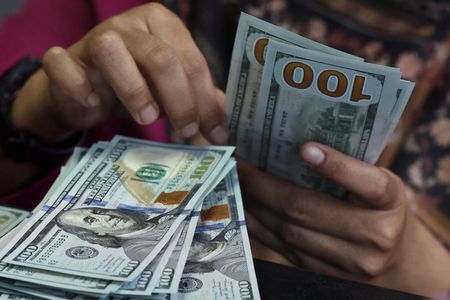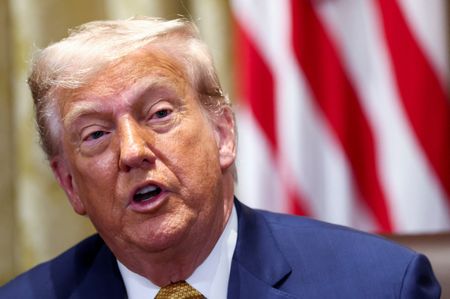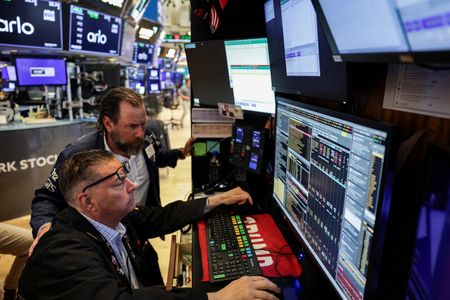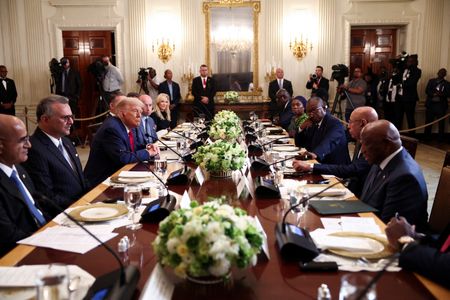By Hannah Lang
NEW YORK (Reuters) -The dollar hovered near more than a two-week high against the yen on Wednesday as U.S. President Donald Trump announced tariffs on seven countries, after earlier this week imposing 25% tariffs on Japan and other trade partners beginning in August. .
The greenback advanced against major peers on Tuesday after Trump issued a round of tariff letters to countries including Algeria, Iraq, Libya, Sri Lanka and the Philippines. Those tariffs — as high as 30% — are due to start on August 1, but Trump said he was open to extensions if countries made proposals.
Trump said on social media that tariff letters to additional countries would be released later Wednesday afternoon, without specifying any details.
Despite recent gains, the dollar index, which measures the greenback against six major peers, is still down more than 6% since Trump on April 2 unveiled his sweeping “Liberation Day” reciprocal tariffs, which prompted a sell-off in markets but were later mostly postponed to give time to negotiate bilateral trade deals.
“There’s been a lot of turbulence in holding the U.S. dollar,” said Juan Perez, director of trading at Monex USA.
“Where do we go now? Well, the uncertainty remains, and I know that that’s a frustrating thing to hear, but this is going to be a roller coaster ride in which … you’re going to have to start embracing and accepting is just part of doing business.”
Trump has also threatened a 50% tariff on imported copper and said he would soon introduce long-threatened levies on semiconductors and pharmaceuticals.
The dollar was down 0.18% at 146.35 yen, after touching 147.19 earlier in the session. The U.S. currency has gained around 1.5% so far this week – the greenback’s biggest weekly rise since mid-December.
Export-dependent Japan stands out among major U.S. trading partners as being the farthest from a deal, and its currency has taken a beating. Multiple rounds of talks have failed to result in a breakthrough, and Japanese policymakers are increasingly focused on a critical upcoming election.
Speculation that opposition parties will gain seats in Japan’s upper house and push for more fiscal stimulus has sent Japanese government bonds (JGBs) lower this week, causing a spike in long-term yields.
U.S. Treasury Secretary Scott Bessent, who has been a key trade negotiator with Tokyo, is expected to attend the World Expo 2025 in Osaka, Japan, later this month, potentially opening the door for more discussions.
The euro slipped 0.09% to $1.171 as investors cautiously weighed the likelihood that the European Union would not receive a tariff letter and could secure exemptions from the U.S. baseline rate of 10%, EU sources familiar with the matter told Reuters.
Minutes from the Federal Reserve’s June 17-18 policy meeting on Wednesday showed that only “a couple” of officials said they felt interest rates could be reduced as soon as this month, with most policymakers remaining worried about the inflationary pressure from Trump’s tariffs.
Antje Praefcke, an FX analyst at Commerzbank, credited the euro’s strength against the dollar also to markets pricing in interest rate differentials between the U.S. and Europe.
“The market is now pricing in just under two interest rate cuts by the Fed by the end of the year, but only one by the ECB.”
The dollar index inched down 0.003% to 97.545, while sterling was down 0.04% at $1.36.
The New Zealand dollar slipped in choppy trading and was last up 0.03% to $0.59 after the country’s central bank left the benchmark interest rate unchanged, as expected, noting near-term inflation risks.
(Reporting by Hannah Lang and Johann M Cherian; Additional reporting by Rocky Swift; Editing by Shri Navaratnam, Jamie Freed, Kate Mayberry, Chizu Nomiyama, Paul Simao and Sandra Maler)










